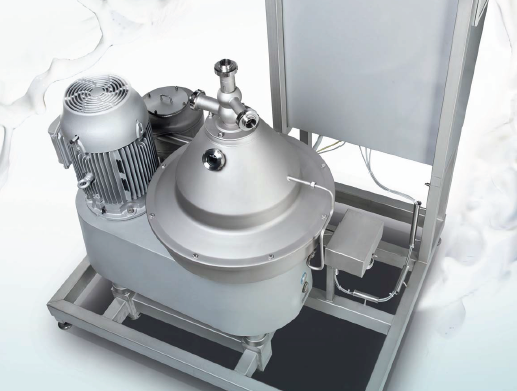DISPATCHES FROM ANUGA FOODTEC 2012
New separator range offers dairy processors cost savings over our competitors: GEA

Speaking to DairyReporter.com about one of the new machines presented at Anuga FoodTec in Cologne last week, Thomas Veer from GEA Westfalia Separator Brazil said that the new bacteria clarifier on show from the Eco separator range (pictured) the Ecoclear, was GEA’s smallest such unit.
Designed for streams ranging from 3,000 to 15,000 litres per hour, the eco separator generation comprises self-cleaning separators for clarification, skimming and bacteria removal.
GEA has also launched Ecoclean and Ecocream models, but Ecoclear is designed to remove bacteria from high-grade dairy products, which can cut shelf life, or (as with Clostridium tyrobutyricumin in cheese) cause a rancid taste.
Undesirable non-milk solids
Clarification involves the removal of particles that are denser than the continuous milk phase, which are thrown back against the perimeter of a centrifuge in a clarifying machine before being ejected; undesirable non-milk solids (NMS) include dirt, epithelial cells, blood cells and bacteria sediment.
Veer said the firm offered an additional option to reduce ejection frequency – the process by which the sediment space is excavated (cleaned) by releasing pressure inside the centrifuge – which also leads to costly milk (and therefore protein) losses.
“Inside the bowl we have a system called protein plus, a fluid mechanics concept scaled-down from GEA’s bigger machines,” Veer told this publication.
“Normally with dairy separators you have bacteria clarifiers that discharge, say, 5kg of milk every 15 minutes. So you are losing 5kg of milk or protein – but we have a special system inside the bowl where the solids (dirt) are concentrated.
“Our discharge is more concentrated, and we are only discharging once per hour. That means processors lose much less milk – a high benefit compared to our competitors.”
Fewer moving parts
The Eco generation uses GEA Westfalia’s Separator hydrosoft feed system, which meant minimal feed pressure, minimum shear forces and thus a high separating efficiency, the firm said.
Motors with frequency converters meant that a clutch was no longer necessary, while a flat-belt drive meant 30% fewer parts and less maintenance, according to GEA.
Discussing the use of frequency converters, Veer said:“This is very important for us – we save energy efficiency [GEA claims 10% power savings] and this provides flexibility.
“We have also stopped using stainless steel cladding [on the outside] of the machine, which is painted with a special core to protect against acid erosion and caustic within dairies.”
Asked where interest in such machines was stemming from, Veer said that bacteria clarifiers were quite common in Europe, but a consolidated industry meant that GEA was mostly selling bigger machines in this region.
He added: “South America is getting more interesting for us due to the growing cheese production, and the US is slowly starting but there the capacities are much higher. India? Not yet, but it’s coming up. China also, because you can use this machine to clarify milk and cut the bacterial load.”








